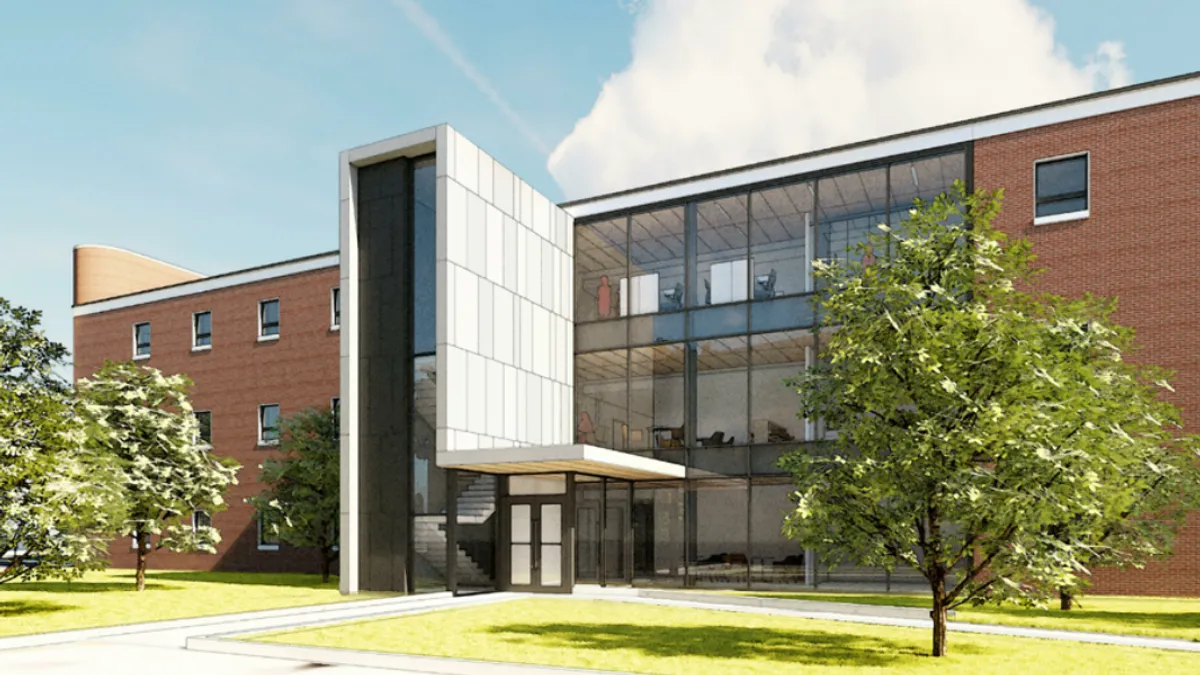The coronavirus pandemic has caused contractors to pivot to new ways of working on projects that were underway before it hit, such as Skanska's renovation of the University of Delaware's Worrilow Hall academic building.
Managers there had to rethink the job midstream as materials and workers became scarce, a limit on travel made some team members unable to visit the jobsite and government and CDC orders mandated new requirements for jobsite cleanliness.
Here, Construction Dive talks with Skanska Executive Vice President and General Manager Todd Lofgren about how his team kept the project running and ensured that workers were safe.
Tell us a bit about the University of Delaware project. Was it delayed by the coronavirus?
Originally built in 1980, the 66,000-square-foot building is the primary laboratory building for the 80 faculty and more than 1,000 students in agriculture and natural resources. The university identified the need for additional flexible space, innovative teaching labs and new equipment, with the goal of promoting students' ability to push barriers and conduct research that has broad global impact.
Worrilow Hall will provide state-of-the-art laboratories and core facilities using a design that transforms the learning and research experience. The new design will include reconfigured learning rooms, updated sensory and testing labs, increased space for graduate students and expanded collaborative space for students.
Throughout the coronavirus pandemic, Skanska has been following city and state guidelines as well as university rules and regulations and working closely and collaboratively with our clients and partners. As a result, the Worrilow Hall renovation project has remained open and is set to reopen this fall.
We did run into delays as they related to manufacturing and delivery of equipment and materials and there was a reduction in the workforce in the initial stages of COVID-19. Working collaboratively with the university and our subcontractors, we split the manpower into one morning shift and one afternoon shift to allow for better social distancing. At this time, manpower counts have returned to pre-COVID numbers.
How do you ensure that employees and subcontractors on the project are comfortable and safe?
In alignment with our core values, Skanska continues to make safety a top priority. To ensure our employees and subcontractors remain safe and healthy, we have instituted a variety of safety protocols at Worrilow Hall.
The first step begins before workers set foot on the worksite. Following CDC guidelines, when workers arrive at the jobsite, they are asked a series of questions such as, “Are you experiencing flu-like symptoms?" and " Have you, or has anyone in your family, been in contact with a person who has tested positive for COVID-19?” We also administer daily temperature checks before workers enters the jobsite.
Once on the jobsite, employees are encouraged wash their hands often and use the hand sanitizers that have been donated by the university and strategically placed near common touch points. We installed multiple mobile hand-washing stations with soap and warm water that can move around the site as the job progresses.
Additionally, the temporary toilets are designated by trade so the same group of people use them throughout the day. They are thoroughly disinfected at regular intervals. Skanska has developed its own face barrier guidelines for employees and subcontractors depending on level of risk, requiring everyone on the jobsite to wear a face covering at minimum in addition to Cut Level 3 gloves and safety glasses.
Since the university transitioned its classes to an online delivery mode for the remainder of the spring semester, the university has allowed our workers to use their on-site parking spaces. This added precaution promotes individuals driving themselves as opposed to carpooling or using other forms of public transportation that would put them in close quarters with others.
What type of technology are you using on the project?
Investing in and leveraging cutting edge technology has always been important at Skanska. Those investments have paid dividends during the pandemic, allowing all our partners to stay up-to-date and collaborate remotely. We are using the online platform StructionSite for virtual job walks and automated jobsite documentation. StructionSite uses advanced 360-degree imagery and videos that capture an immersed jobsite experience. The benefits of the system became apparent to us prior to the coronavirus pandemic, and we are thrilled to have a technology solution where everyone can take comfort in seeing the project meet milestones.
In addition to virtual job walks, StructionSite is also serving as our digital project archive, documenting the progress of the project from start to finish. We also can upload project floor plans to StructionSite and sync them with 360-degree photos. Our team has also been using Webex to conduct real-time virtual tours of the project.
What are your biggest concerns going forward?
One concern we have is the impact of COVID-19 on our manufacturing partners, and how that will impact their ability to deliver materials on time. As construction sites re-open across the country, this process may be even more unpredictable and could have the potential to slow down construction.
Our other concern remains where it has always been — maintaining the safety of our workers. The coronavirus pandemic has required us to increase our already heavy focus on safe working conditions. We must ensure that everyone remains diligent wearing face masks and barriers, even as we enter the warmer summer months.




















